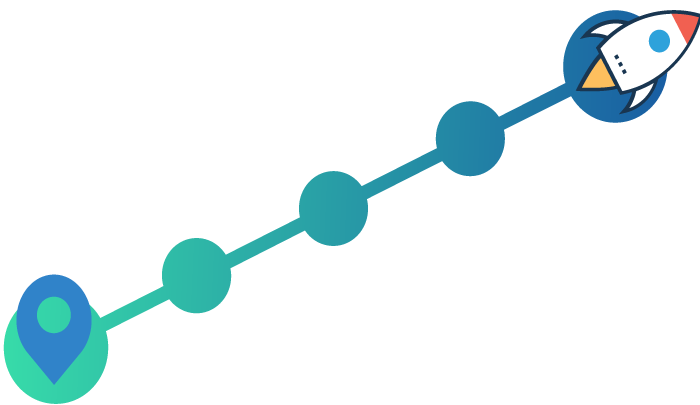In the ever-evolving world of digital analytics, tracking user behaviour and collecting data is crucial for optimising website performance, improving user experience, and driving business growth.
When it comes to implementing analytics tracking, businesses have two distinct options; client-side tracking or server-side tracking. Each method has its own advantages and drawbacks, and choosing the right approach depends on your specific needs and goals. In this blog, we’ll explore the pros and cons of both client-side and server-side analytics tracking to help you make an informed decision.
What is Client-Side Analytics Tracking?
Client-side analytics tracking involves placing a small piece of JavaScript code on your website, which runs in the user’s browser. This script collects data about user interactions, such as page views, clicks, form submissions, and other activities, and then sends this data to an analytics platform for processing and analysis.

Client-Side Analytics Tracking Pros
- Ease of Implementation:
- Client-side tracking is relatively easy to implement. By simply adding a JavaScript snippet to your website’s code, you can start collecting data without needing extensive backend development.
- Real-Time Data:
- Since the tracking script runs directly in the browser, data is collected and sent to your analytics platform in real-time, providing immediate insights into user behaviour.
- Rich Data Collection:
- Client-side tracking can capture a wide range of user interactions, including clicks, scrolls, mouse movements, and form inputs. Additionally, it can collect detailed information about the user’s device, such as screen resolution, browser type, and operating system.
- Third-Party Integrations:
- Many popular analytics tools, like Google Analytics, offer robust client-side tracking capabilities, along with a variety of integrations and plugins that enhance functionality and reporting.
- Quick Adjustments:
- Adjusting your tracking setup to include new web content or features is often as simple as updating the JavaScript code, which can be done without redeploying your entire website.
Client-Side Analytics Tracking Cons
- Ad Blockers and Privacy Tools:
- Many users employ ad blockers or privacy-focused browser extensions that can block client-side tracking scripts, leading to incomplete or inaccurate data collection.
- Performance Impact:
- Adding extra JavaScript to your website can affect page load times, particularly if you’re using multiple tracking scripts. Slow load times can negatively impact user experience and SEO rankings.
- Security and Data Integrity:
- Client-side data is potentially vulnerable to tampering or manipulation by malicious users. Since it relies on the user’s device, the integrity of the data collected isn’t always guaranteed.
- Data Limitations:
- Certain data, like server-side errors or interactions that happen before the page fully loads, may be missed or not captured accurately.
What is Server-Side Analytics Tracking?
Server-side analytics tracking, on the other hand, involves collecting data directly on your server before it’s sent to your analytics platform. This method captures data from server requests and backend processes, providing a more reliable and secure way to track user behaviour.

Server-Side Analytics Tracking Pros
- Accuracy and Reliability:
- Since server-side tracking isn’t affected by client-side issues like ad blockers or JavaScript errors, it tends to be more accurate and reliable. It captures all requests made to your server, ensuring you don’t miss any data.
- Security:
- Server-side data is less susceptible to tampering or manipulation. By processing data on the server, you maintain greater control over its integrity and security.
- Performance:
- Server-side tracking doesn’t impact page load times because it doesn’t rely on running additional scripts in the user’s browser. This can lead to a smoother user experience.
- Consistent Data:
- Regardless of the user’s device or browser settings, server-side tracking ensures consistent data collection, providing a more comprehensive view of user behaviour.
- Complex Data:
- Server-side tracking allows you to capture backend events and data, such as API requests, server errors, and transactions that aren’t visible to the client-side. This data can be crucial for understanding the full user journey
Server-Side Analytics Tracking Cons
- Complexity of Implementation:
- Implementing server-side tracking is typically more complex and requires deeper integration with your backend infrastructure. This may necessitate additional development resources and expertise.
- Limited Client-Side Data:
- Collecting detailed information about user interactions, like clicks and scrolls, is more challenging with server-side tracking. You might need to combine it with client-side mechanisms to capture a complete picture.
- Lack of Real-Time Data:
- Server-side data might not be available in real-time, as it often requires processing or aggregation before it can be used for analysis. This could delay insights and decision-making.
- Scalability:
- For high-traffic websites, server-side tracking can increase the load on your server, potentially requiring additional resources or scaling solutions to handle the data collection efficiently.
- Integration Challenges:
- While server-side tracking provides greater control, some third-party analytics services are more tailored to client-side tracking. This can make server-side integration more complex and limit the use of certain features.
Choosing the Right Approach: Client-Side, Server-Side, or Both?
So, which approach should you choose? The answer largely depends on your specific reporting needs, technical capabilities, and budget.
- Use Client-Side Tracking if you need to capture detailed information about user interactions, require a quick and easy setup, and can tolerate potential data gaps due to ad blockers or privacy tools.
- Use Server-Side Tracking if data accuracy, security, and integrity are top priorities, or if you need to capture backend events and server-side data that aren’t accessible through client-side methods.
In many cases, a hybrid approach combining both client-side and server-side tracking can provide the best of both worlds. By leveraging the strengths of each method, you can achieve a more comprehensive and reliable analytics setup, ensuring that you have all the data you need to make informed decisions and drive your business forward.

Conclusion
Both client-side and server-side analytics tracking have their pros and cons. By understanding these differences and aligning them with your goals, you can select the best approach for your website or application. Whether you choose one method or a combination of both, the key is to ensure that your analytics setup provides accurate, reliable, and actionable insights to fuel your success.
The team at Element78 can help guide you on your choices. We will be driven by what you need the analytics for, to ensure you have reporting that can help drive understanding and improvement. Whether it is optimising your existing set up, through to proposing new tools and approaches, please reach out to us about our experience with tools such as Matomo, Umbraco Marketing Suite and advanced GA4 set up.


